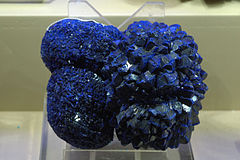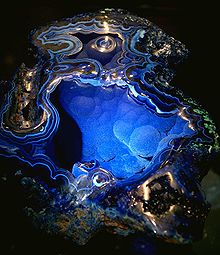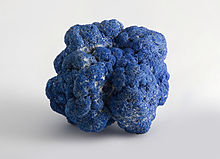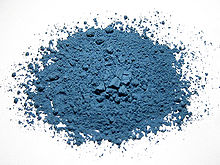- Azurite
-
- Azurite may also refer to a blue Green fluorescent protein derivative.
For the DFPSO vessel, see Azurite DFPSO.Azurite 
Azurite from China with large crystals and light surface weathering.General Category Carbonate mineral Chemical formula Cu3(CO3)2(OH)2 Strunz classification 05.BA.05 Crystal symmetry Monoclinic 2/m Unit cell a = 5.01 Å, b = 5.85 Å, c = 10.35 Å; β = 92.43°; Z=2 Identification Molar mass 344.67 g/mol Color Azure-blue, Berlin blue, very dark to pale blue; pale blue in transmitted light Crystal habit Massive, prismatic, stalactitic, tabular Crystal system Monoclinic Prismatic Twinning Rare, twin planes {101}, {102} or {001} Cleavage Perfect on {011}, fair on {100}, poor on {110} Fracture Conchoidal Tenacity brittle Mohs scale hardness 3.5 to 4 Luster Vitreous Streak Light Blue Diaphaneity Transparent to translucent Specific gravity 3.773 (measured), 3.78 (calculated) Optical properties Biaxial (+) Refractive index nα = 1.730 nβ = 1.758 nγ = 1.838 Birefringence δ = 0.108 Pleochroism Visible shades of blue 2V angle Measured: 68°, calculated: 64° Dispersion relatively weak References [1][2][3] Azurite is a soft, deep blue copper mineral produced by weathering of copper ore deposits. It is also known as Chessylite after the type locality at Chessy-les-Mines near Lyon, France.[2] The mineral has been known since ancient times, and was mentioned in Pliny the Elder's Natural History under the Greek name kuanos (κυανός: "deep blue," root of English cyan) and the Latin name caeruleum.[4] The blue of azurite is exceptionally deep and clear, and for that reason the mineral has tended to be associated since antiquity with the deep blue color of low-humidity desert and winter skies. The modern English name of the mineral reflects this association, since both azurite and azure are derived via Arabic from the Persian lazhward (لاژورد), an area known for its deposits of another deep blue stone, lapis lazuli ("stone of azure").
Contents
Mineralogy
Azurite crystals are monoclinic, and when large enough to be seen they appear as dark blue prismatic crystals.[2][3][5] Azurite specimens are typically massive to nodular, and are often stalactitic in form. Specimens tend to lighten in color over time due to weathering of the specimen surface into malachite. Azurite is soft, with a Mohs hardness of only 3.5 to 4. The specific gravity of azurite is 3.77 to 3.89. Azurite is destroyed by heat, losing carbon dioxide and water to form black, powdery copper(II) oxide. Characteristic of a carbonate, specimens effervesce upon treatment with hydrochloric acid.
Uses
Pigments
Azurite was used as a blue pigment for centuries. Depending on the degree of fineness to which it was ground, and its basic content of copper carbonate, it gave a wide range of blues. It has been known as mountain blue or Armenian stone, in addition it was formerly known as Azurro Della Magna (from Italian). When mixed with oil it turns slightly green. When mixed with egg yolk it turns green-grey. It is also known by the names Blue Bice and Blue Verditer, though Verditer usually refers to a pigment made by chemical process. Older examples of azurite pigment may show a more greenish tint due to weathering into malachite. Much azurite was mislabeled lapis lazuli, a term applied to many blue pigments. As chemical analysis of paintings from the Middle Ages improves, azurite is being recognized as a major source of the blues used by medieval painters. True lapis lazuli was chiefly supplied from Afghanistan during the Middle Ages while azurite was a common mineral in Europe at the time. Sizable deposits were found near Lyons, France. It was mined since the 12th century in Saxony, in the silver mines located there.[6]
Azurite was distinguished from (the much more expensive) purified natural ultramarine blue by heating (as described by Cennino D'Andrea Cennini). Ultramarine withstands heat, whereas azurite turns black (copper oxide). Gentle heating of azurite produces a deep blue pigment used in Japanese painting techniques.
Jewelry
Azurite is used occasionally as beads and as jewelry, and also as an ornamental stone. However, its softness and tendency to lose its deep blue color as it weathers limit such uses. Heating destroys azurite easily, so all mounting of azurite specimens must be done at room temperature.
Collecting
The intense color of azurite makes it a popular collector's stone. However, bright light, heat, and open air all tend to reduce the intensity of its color over time. To help preserve the deep blue color of a pristine azurite specimen, collectors should use a cool, dark, sealed storage environment similar to that of its original natural setting.
Prospecting
While not a major ore of copper itself, azurite is a good surface indicator of the presence of weathered copper sulfide ores. It is usually found in association with the chemically very similar malachite, producing a striking color combination of deep blue and bright green that is strongly indicative of the presence of copper ores.
History
The use of azurite and malachite as copper ore indicators led indirectly to the name of the element nickel in the English language. Nickeline, a principal ore of nickel that is also known as niccolite, weathers at the surface into a green mineral (annabergite) that resembles malachite. This resemblance resulted in occasional attempts to smelt nickeline in the belief that it was copper ore, but such attempts always ended in failure due to high smelting temperatures needed to reduce nickel. In Germany this deceptive mineral came to be known as kupfernickel, literally "copper demon". The Swedish alchemist Baron Axel Fredrik Cronstedt (who had been trained by Georg Brandt, the discoverer of the nickel-like metal cobalt) realized that there was probably a new metal hiding within the kupfernickel ore, and in 1751 he succeeded in smelting kupfernickel to produce a previously unknown (except in certain meteorites) silvery white, iron-like metal. Logically, Cronstedt named his new metal after the nickel part of kupfernickel. An unintended later consequence of his choice is that both Canadian and American coins worth one-twentieth of a dollar are now named after a German term for "kobolds"—that is, they are called nickels.
Composition
 Azurite deposits on the interior surface of a geode
Azurite deposits on the interior surface of a geode
Azurite is one of two basic copper(II) carbonate minerals, the other being bright green malachite. Simple copper carbonate (CuCO3) is not known to exist in nature. In azurite, copper(II) is linked to two different anions, carbonate and hydroxide; the compound has the formula Cu3(CO3)2(OH)2. The optical properties (color, intensity) of minerals such as azurite and malachite are explained in the context of conventional electronic spectroscopy of coordination complexes. Relatively detailed descriptions are provided by ligand field theory. Small crystals of azurite can be obtained by rapidly stirring a few drops of copper sulfate solution into a saturated solution of sodium carbonate and allowing the solution to stand overnight.
Weathering
Azurite is unstable in open air with respect to malachite, and often is pseudomorphically replaced by malachite. The weathering process involves the replacement of some the carbon dioxide (CO2) units with water (H2O). This changes the carbonate:hydroxide ratio of azurite from 1:1 to the 1:2 ratio of malachite:
- 2 Cu3(CO3)2(OH)2 + H2O → 3 Cu2(CO3)(OH)2 + CO2
From the above equation, the conversion of azurite into malachite is attributable to the low partial pressure of carbon dioxide in air. Azurite is also incompatible with aquatic media, such as saltwater aquariums.
References
- ^ Handbook of Mineralogy
- ^ a b c Mindat.org
- ^ a b Webmineral.com Webmineral Data
- ^ The Ancient Library: Smith, Dictionary of Greek and Roman Antiquities, p.321, right col., under BLUE
- ^ Hurlbut, Cornelius S.; Klein, Cornelis, 1985, Manual of Mineralogy, 20th ed., Wiley, ISBN 978-0-471-00042-6
- ^ Andersen, Frank J. "Riches of the Earth" W.H. Smith Publishers, New York 1981, ISBN 0-8317-7739-7
See also
Categories:- Copper minerals
- Carbonate minerals
- Inorganic pigments
- Gemstones
- Monoclinic minerals
Wikimedia Foundation. 2010.



